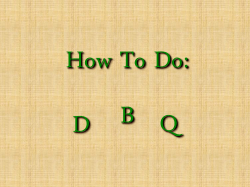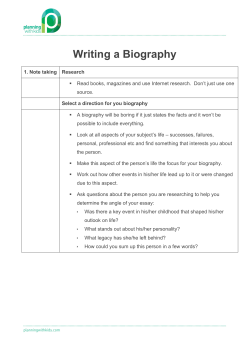
How to Create a Historical Documentary What is a Historical Documentary?
How to Create a Historical Documentary What is a Historical Documentary? NHD documentaries present information about an event, person, place or idea from the past through a ten minute presentation that showcases documents, images, photographs, and actual footage of the topic you are researching. Your documentary needs to have both primary and secondary research but also be an original production. How is a Documentary Different from Other Categories? Creating a documentary is different from other categories because of the technology necessary. Before deciding to create a documentary, you should ask yourself the following questions: Am I interested in using computers, cameras, and other technologies? Can I conduct and record interviews (for the purpose of including film clips in the documentary)? Can I find film clips to use in my documentary? Are there enough still photographs related to my topic and that I can use in my documentary? Do I have access to equipment that will be needed to make a documentary? Is creating a documentary the best way to show off my topic? Getting Started Create a Documentary Notebook to write down all of your ideas and keep your research organized. Watch historical documentaries and write a list of what you think makes a great historical documentary Make sure you have access to -a computer -a video camera -editing software -supplies: batteries, blank DVDs or videotapes, paper, pens, props Research the topic first. One way to choose your topic is to select a commonly known story and then find a different angle that brings something new to it. Remember that there are many unknown stories that also should be told. Regardless of the topic you select, choose one that truly interests you, and remember to put it into historical context. Keep a database. It is important that you have a database where you keep track of all of the information you are gathering. A database is simply any place where you can collect and easily access your sources and production materials. Create a Timeline. Before you jump into your project, it is a good idea to create a preliminary timeline of when you want to finish important steps along the way, especially the start and end dates of preproduction, research, production, and post-production. Create a budget. On the practical side, you need to have a sense of the costs of doing this project. Remember you don't have to break the bank to make a film. Spending more money does not make a film better in quality. How to Create a Historical Exhibit What is a Historical Exhibit? Historical exhibition presents information about an event, person, place, or idea from the past by physically displaying documents, images, or objects. We often see such exhibits at museums, but they are also presented at many other places such as archives, historic sites, park visitor centers, classrooms, and even airports and train stations. For your National History Day project, you will tell the story of your research through historic photographs, maps, drawings and other interesting objects. How is an Exhibit Different from Other Categories? The exhibit category is three dimensional and is displayed on a physical structure. Exhibits use color, images, documents, objects, graphics, and design, as well as words, to tell your story. Exhibits can be interactive experiences by asking viewers to play music, solve a puzzle, look at a video, or open a door or window to see more documents or photos. Getting Started Brainstorm topics that are of interest to you and are related to this year's NHD theme. Research the topic first. Do your secondary research first. Reading secondary resources will help you understand your subject more completely, point you to primary sources, and assist you in selecting the important themes you want to investigate and the key questions you want to ask. Select items to put on the exhibit. You won't be able to use all the materials you find while doing your research. As you think about what to put on the exhibit, ask yourself the following questions: Does the item fit in with the NHD theme and the theme of your exhibit? -Does the item advance the story you are trying to tell? -Is a document you are thinking of displaying too long or too wordy? Is it easy to read and understand? Will it take up too much space in your exhibit? -Is the item visually interesting? -What images best tell your story? -Do you want to include artifacts in your exhibit? -Will your exhibit contain audiovisual materials? Prepare the script. Writing your titles, text, and labels is often referred to as writing the script. Like all good writing, your exhibit script needs to be grammatically correct, use good sentence structure, make wise word choices, and contain no spelling errors. You should expect to write several drafts. Exhibit labels are brief, so they need to be clear and concise. How to Create a Historical Paper What is a Historical Paper? History papers present information and analyze an event, person, place or idea from the past in writing. Although you might attach a map, chart or photograph that you refer to in your paper, you will rely mainly on words. Writing a paper is a chance to tell what you know and what you think about a part of the past. How is a Paper Different from Other Categories? A paper is a highly personal and individual effort, and if you prefer to work alone this may be the category for you. Papers depend almost entirely on words to tell the story, and you can usually include more information in a paper than in some of the other categories. Getting Started Conduct your research. Examine secondary and primary sources, taking careful notes and keeping track of which source each piece of information came from. From your research, you should come up with your thesis – the argument you want to make in your paper. Make an outline. Using your notes, you can create a list of the main information you want to include in your paper, where each piece of information will go, and in what order. This will help when you sit down to write your paper. Start writing. You might begin by writing your introduction in which you state your thesis. -Introduction: your introduction should tell the reader where you intend to go with the rest of your paper. -Body: the main body of your paper is where you can make the case for your conclusion. Present your evidence, the primary sources, and your analysis of how they support your thesis. -Conclusion: your conclusion is like the summary of your paper. It should summarize your main points that prove your thesis. Read and Revise. A polished product takes time, so it is important to re-read and revise your paper. Check for clarity, unity, and coherence. Is it clear how your topic relates to the NHD theme? Does your conclusion flow logically from your thesis? How to Create a Historical Performance What is a Historical Performance? A performance is a live, dramatic presentation of your topic's significance in history. You may perform individually or as part of a group. A performance should be a scripted portrayal based on research of your chosen topic. Your script should be structured on a thesis statement, supporting statements, and a conclusion. Your performance should have dramatic appeal, but not at the expense of historical information. How is a Performance Different from Other Categories? The performance category is the only one that is presented live. Developing a strong narrative that allows your subject to unfold in a dramatic and visually interesting way is important. Memorizing, rehearsing, and refining your script is essential, so you should schedule time for this in addition to research, writing, costuming and prop gathering. Getting Started Decide whether the chosen topic will be most effective as a group or as an individual performance. Research the topic first. Write down important facts or quotes that may be important to the performance. Write a thesis statement, supporting statements and a conclusion. Think about how these might become part of your performance. Prepare a script. Brainstorm with general ideas and how they might be presented. If a group is performing, each member should describe different ways in which characters might interact. -Make sure your script contains references to the historical evidence found in your research. -Using actual dialogue, quotations, or brief excerpts from speeches are good ways to put historical detail into your performance. -Remember that your script should center on the thesis statement, supporting statements, and the conclusion that you developed from your research. Prepare the set. Think about different types of sets that might help depict your topic. Is there a prop that is central to the story? Prepare the blocking. To "block" a performance is to determine where the actors will stand, move, and/or relate to the set. You should think about these movements when deciding what type of set to design. Prepare the costuming. Good costumes help make a performer convincing, but make sure they are appropriate to the topic. You do not need to purchase or make an elaborate costume - sometimes simple works best (e.g. white shirt and dark pants/skirt can fit almost any time period). Practice, practice, practice! Work on speaking clearly, pronouncing all words correctly, and projecting your voice so that the judges and the audience can hear every word. Rehearse with the set and full costumes as often as possible. How to Create a Historical Web Site What is a Historical Web Site? A historical web site is a collection of web pages, interconnected with hyperlinks, that presents primary and secondary sources, interactive multimedia, and historical analysis. Your web site should be an accumulation of research and argument that incorporates textual and non-textual (photographs, maps, music, etc.) description, interpretation, and multimedia sources to engage and inform viewers about your chosen historical topic. How is a Web Site Different from Other Categories? Web sites can display materials online, your own historical analysis as well as primary and secondary sources. These can be photographs, maps, documents, or audio and video files. Web sites are interactive experiences where viewers can play music, solve a puzzle, or look at a video or click on different links. Viewers can move through the web site in various undirected ways. Web sites use color, images, fonts, documents, objects, graphics and design, as well as words, to tell your story. Getting Started Decide whether you want to create your web site as part of a group or on your own. Research your topic first. Examine secondary and primary sources. From this research, create your thesis. This will be the point that you want to make with your historical web site. Narrow in on the content of your web site. Decide what information you want to incorporate in your web pages, including any photos, primary documents, or media clips you may have found. You should be sure to have plenty of supporting information for your thesis. Create your website with the NHD Site Editor. Click here to begin the registration process. Organize and Design -Keep It Simple: don't waste too much time on bells and whistles. Tell your story and tell it straight. -Borrow Ideas from Other Web Sites: find design elements that work and imitate them on your web site. Just remember to give credit where credit is due. -Make sure every element of your design points back to your topic, thesis, and/or time period. There should be a conscious reason for every choice you make about color, typeface, or graphics. NEW for 2014! With so many complains in the past with the Scrib.d element on NHD Weebly we have removed this element and recommend students post their Bibliographies and Process papers as PDF files on their web sites with the "File" element under 'Media'.
© Copyright 2025
















